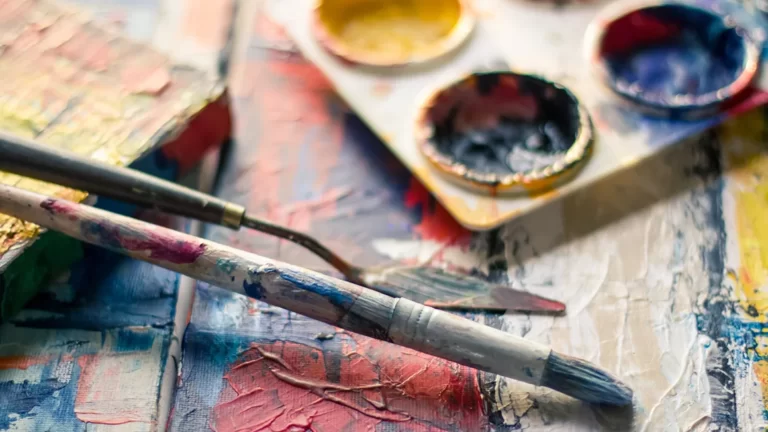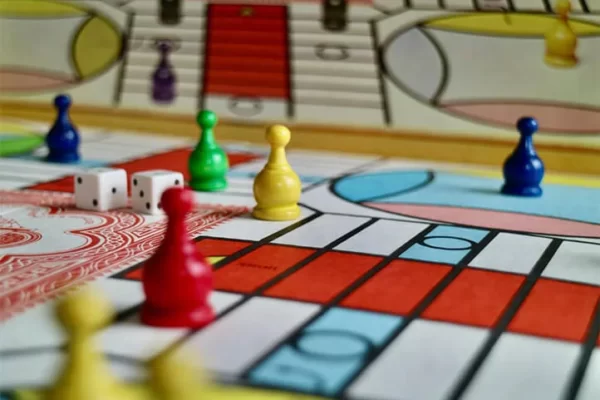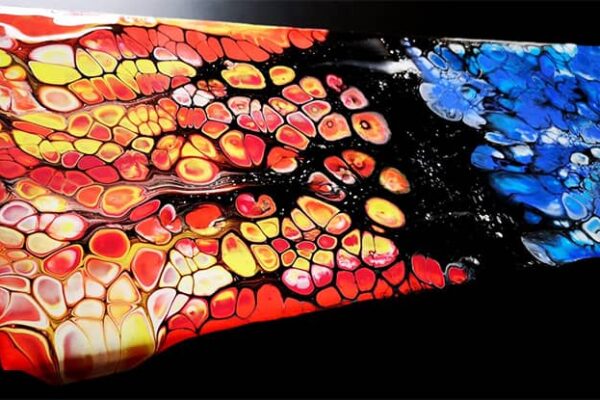Art therapy is a type of psychotherapy that uses the creative process to improve and enhance the physical, mental, and emotional well-being of individuals of all ages. It is based on the belief that creative expression helps people resolve conflicts and problems, develop interpersonal skills, manage behavior, cope with stress, increase self-esteem and self-awareness.
In different countries, art therapy may have different approaches and theories. However, the common goal is to integrate physical, emotional, and social well-being through creative and reflective interaction with art.
Art therapy is beneficial for people of all ages and in various life circumstances. This can include individuals, couples, families, groups, and communities. Art therapy can be applied in medical, educational, and correctional institutions, as well as in private psychological practice, to improve mental health and aid in rehabilitation.
Art therapists typically have specialized education and training in the field of art and therapy, including theory and practice in psychology and creative processes.
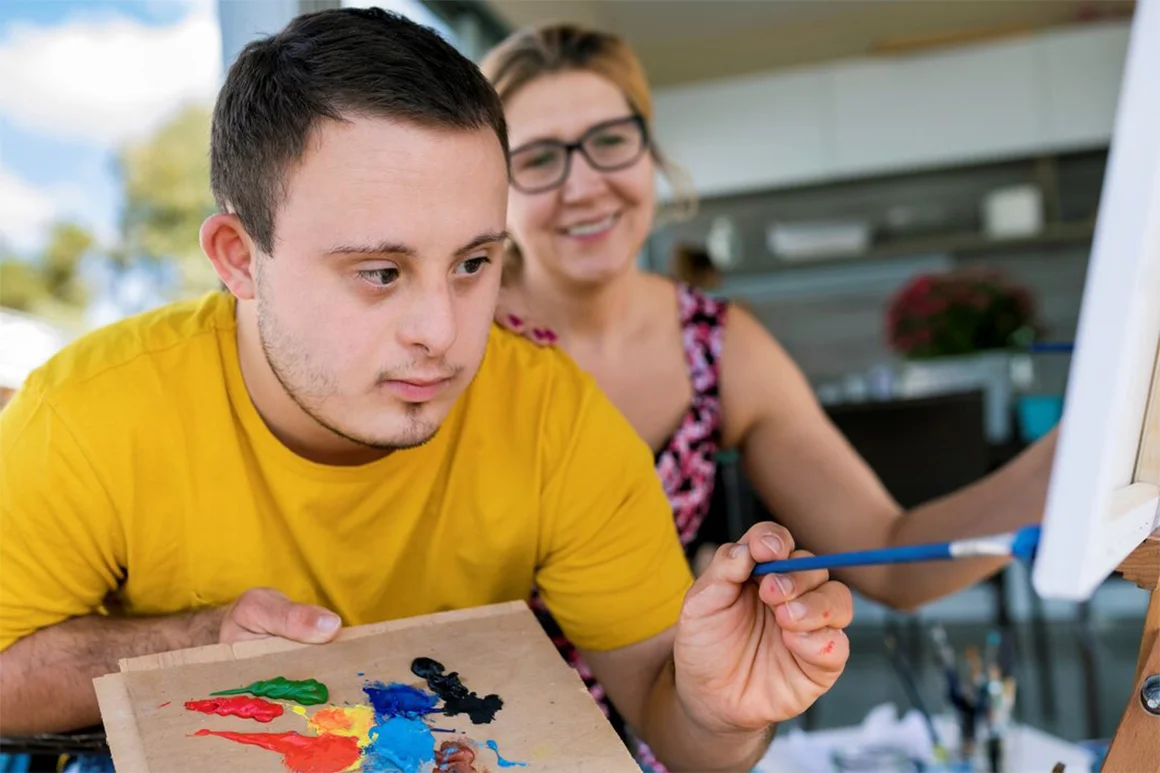
The Importance of Art Therapy in the Modern World
In today’s fast-paced, stressful, and complex world, art therapy plays an important role. Here are a few reasons why it is so significant today:
- Reducing stress and anxiety. People often face stress and anxiety due to various reasons, ranging from professional responsibilities to personal problems. Art therapy helps alleviate these feelings by providing a channel for self-expression and the ability to transform emotions into creativity.
- Enhancing self-awareness. Art therapy helps individuals better understand themselves by recognizing and analyzing their feelings and emotions through their creativity.
- Improving communication. For some people, especially those who struggle to express their feelings with words, art therapy can become an invaluable means of communication.
- Healing trauma. Art helps cope with traumatic memories and experiences in a safe and supportive environment.
- Supporting mental health. Art therapy is an important tool in supporting mental health, helping people overcome depression, anxiety, and other mental disorders.
- Accessibility. Art therapy is considered an accessible form of therapy as it does not require many materials or expenses. Anyone can try it, regardless of age, experience, or creative skills.
Overall, in the modern world, where the need for an integrative approach to health and well-being is becoming increasingly apparent, art therapy plays a vital role.
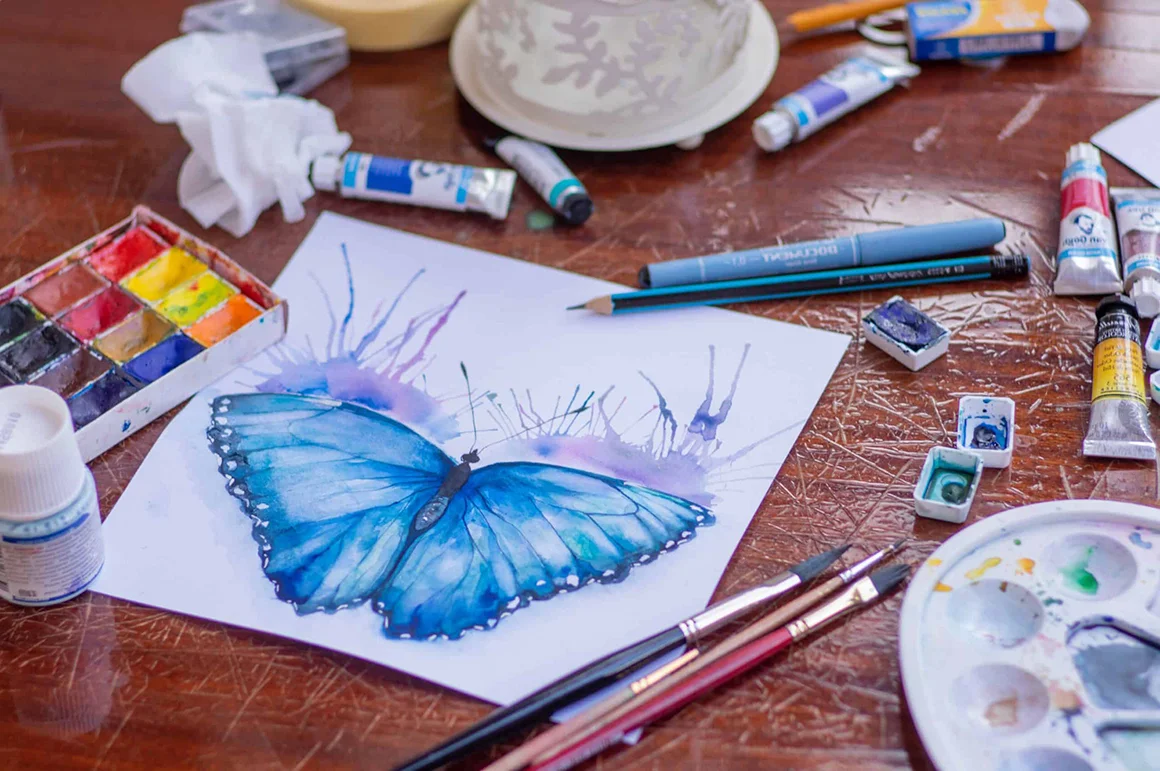
History and Origins of Art Therapy
Art therapy has ancient roots, but it began to form as an academic discipline and profession in the mid-20th century.
In ancient communities, art was used as a means of communication, expression of emotions, and spiritual practices. Cave paintings, ritual dances, and music are all examples of using art to express experiences and communicate with the supernatural.
The modern practice of art therapy began to take shape in the 1940s when doctors working with mental illnesses discovered that art helped patients explain what they could not express in words.
Throughout the 20th century, art therapy continued to develop. In the 1960s, the American Art Therapy Association was founded in the United States, laying the foundation for the profession of art therapists. This period was marked by active research in the field of art therapy and the creation of educational programs to train specialists.
In Europe, art therapy also developed, especially in the United Kingdom, where the British Association of Art Therapists was established in the 1960s.
Since then, art therapy has continued to expand and evolve as a professional discipline. It is recognized as an important form of psychotherapy and is used in various fields—from medicine and education to rehabilitation programs.
Today, art is increasingly used in scientific research due to its unique ability to help people express complex thoughts and feelings. Moreover, it serves as an important channel for processing traumatic memories and difficult life circumstances.
Various forms of art, such as painting, sculpture, collage, photography, music, dance, theater, and more, are used in art therapy to support people of all ages and with different conditions. Whether for those suffering from mental disorders or those seeking personal growth, art therapy offers support on the path to healing and self-discovery.
Like other forms of therapy, art therapy is constantly evolving, and art therapists continue to explore new approaches and methods to improve their practice and provide the most effective treatment for their patients.
Today, many countries around the world have educational programs for art therapists, as well as national and international organizations that support the profession and promote art therapy as an important field of psychotherapy.
Thus, art therapy has come a long way from ancient forms of art to modern therapeutic practice, becoming an important tool for improving the mental health and well-being of people worldwide.
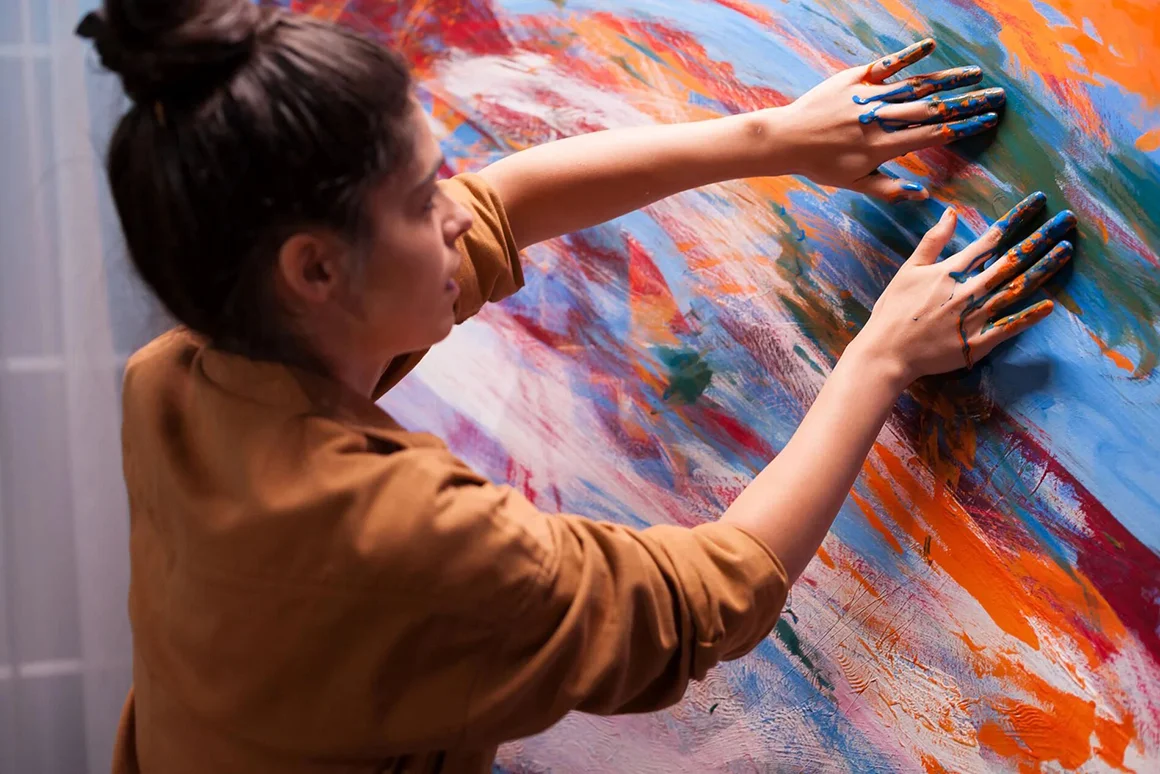
Development and Progress of Art Therapy
The development of art therapy continues as more research confirms its effectiveness and expands our understanding of its potential. Here are some areas where progress is evident:
- Neuroscience and Art Therapy: Neuroscience is beginning to explain why art therapy works on a biological level. Research shows that the creative process affects the brain, helping to improve memory and concentration, reduce stress, and stimulate the production of endorphins (hormones of happiness).
- Digital Art Therapy: With the advancement of digital technologies, new opportunities for art therapy are emerging. This includes the use of virtual reality, digital art, and online art therapy sessions, making it more accessible to a larger number of people.
- Integrative Approach: Modern medicine increasingly recognizes the importance of a holistic approach to health, which considers the physical, mental, and emotional state of the patient. Art therapy fits well into this model as it addresses all these aspects of health.
- Art Therapy and Traditional Healthcare: More hospitals, clinics, schools, and other institutions are beginning to integrate art therapy into their services. This is done both for the treatment of specific illnesses and as part of programs to improve overall well-being.
- More Research: In recent years, researchers have been paying more attention to art therapy, collecting empirical data that supports its effectiveness. This helps strengthen the scientific foundation of the field and increase its recognition in the scientific community.
Overall, the development and progress in art therapy continue, expanding the boundaries of this field and confirming its powerful potential. New approaches and innovations, supported by scientific research, open up new possibilities for using the creative process for treatment, recovery, and improving the quality of life.
The connection of art, science, and technology makes art therapy even more effective and accessible, allowing it to positively impact an increasing number of people.
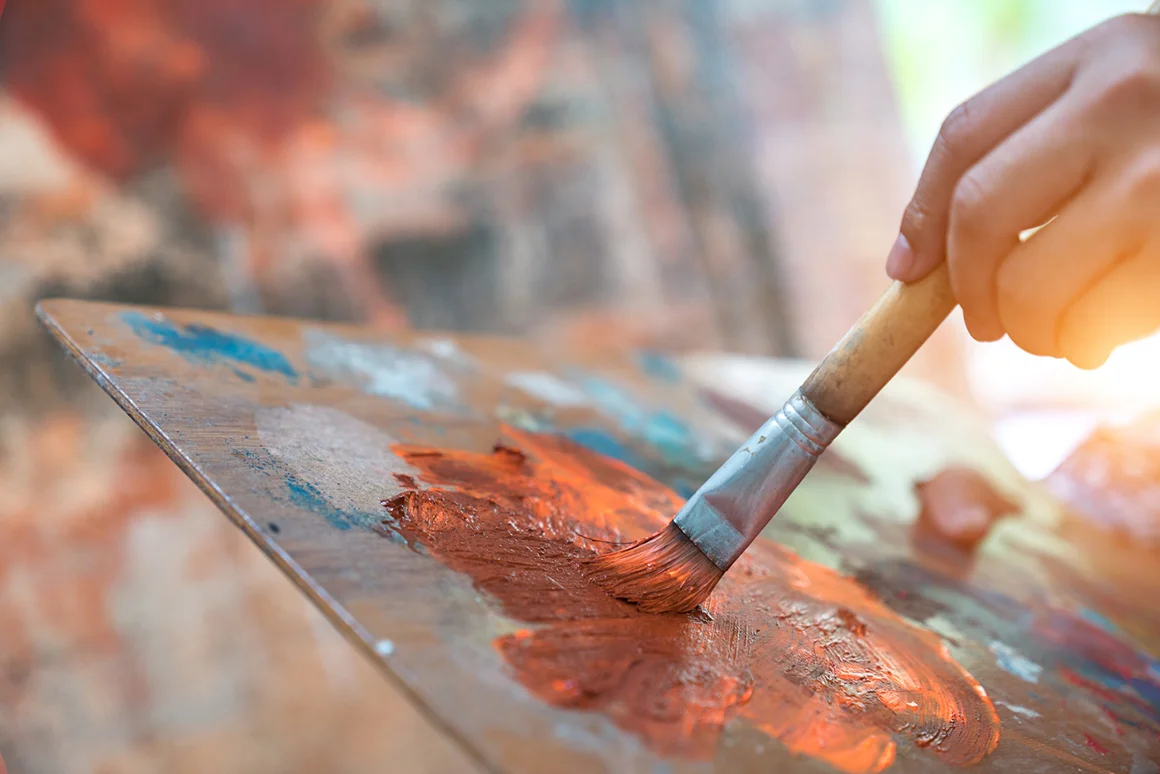
Basics of Art Therapy
Art therapy is a form of psychotherapy that uses art as a means of self-expression and communication. In art therapy, the end result (the created artwork) is less important than the creative process itself. It is based on the belief that the creative process helps people resolve conflicts, develop interpersonal skills, manage behavior, reduce stress, increase self-esteem and self-awareness, and understand their feelings.
The process of art therapy typically involves certain types of creative activities under the guidance of an art therapist, who helps the patient “read” the emotions and ideas expressed in the art and develop strategies for managing specific problems or achieving goals. Art therapy can be conducted in individual or group settings and is beneficial for people with a wide range of mental or physical illnesses.
Theoretical Foundations and Principles
Art therapy is based on theoretical foundations and principles that bridge the fields of psychology and art. Here are the main ones:
- Psychodynamic Theory, inspired by the works of Freud and Jung, is one of the main approaches in art therapy. Here, creativity is used as a means to understand and work with unconscious thoughts and feelings.
- Phenomenology focuses on individual perception of the world and experiences, making art therapy personal and unique for each person.
- Humanistic Psychology emphasizes freedom of choice, personal growth, and self-awareness. Art therapy uses these principles to support personal development and self-expression through art.
- Systems Theory views the individual in the context of their relationships with society, allowing art therapy to consider the interrelationships and dynamics of the group in group art therapy.
- Cognitive-Behavioral Approach uses art as a tool to change negative thought patterns and behaviors.
- Trauma-Informed Approach: In modern art therapy practice, increasing attention is paid to the impact of traumatic events on the individual. This approach aims to reduce the consequences of trauma for each person.
These principles and approaches can intersect and combine in art therapy practice depending on the needs and goals of the specific client or group.
Types of Art Therapy
Art therapy can take various forms, depending on the materials and creative process used. Here are some of the main types:
- Painting Therapy: Patients use brushes, paints, and canvases to create images that reflect their feelings and emotions.
- Sculpture Therapy: This approach involves using clay, plasticine, or other materials to create three-dimensional objects that represent the physical expression of inner experiences.
- Music Therapy: Patients can create music or use it as a means of self-expression and improving their emotional state.
- Dance/Movement Therapy: This approach uses movement and dance as a form of self-expression and processing emotions and bodily sensations.
- Photo Therapy: Photographs are used to explore personal history, identity, and memories.
- Psychodrama: Includes role-playing, improvisation, and the use of theatrical techniques for self-expression and addressing personal problems.
- Writing Therapy: Written self-expression helps people work through their thoughts and feelings.
- Digital Art Therapy: This modern form of psychotherapy uses digital technologies such as computer art and virtual reality for self-expression.
It is important to remember that these approaches can be adapted and combined according to the individual needs and preferences of each patient.
Methods and Techniques of Art Therapy
Art therapy uses a variety of methods and techniques to stimulate creative self-expression and build a deeper understanding of the client’s feelings and experiences. Here are some of them:
- Free Drawing or Creativity: This approach allows clients to freely express their feelings and emotions through any form of art without any restrictions or instructions.
- Directed Drawing: In this case, the art therapist may suggest a theme or subtheme for creativity that helps the individual focus on specific feelings or experiences.
- Collage Making: Using various materials such as photographs, magazine cutouts, fabrics, etc., helps clients visualize and process their feelings and experiences.
- Sculpting or Modeling: Working with three-dimensional materials such as clay or plasticine allows people to consider their feelings and experiences from different angles.
- Work with Metaphors and Symbols: Art therapists often help clients find and use metaphors and symbols in their creativity to facilitate the expression and understanding of complex feelings and ideas.
- Creative Writing: Involves writing poems, stories, or journal entries in addition to or instead of visual art.
- Group Art Therapy: A format where participants work together on projects or discuss their art with others.
By applying these principles, approaches, and techniques, art therapy provides a powerful tool for healing, self-discovery, and personal growth.
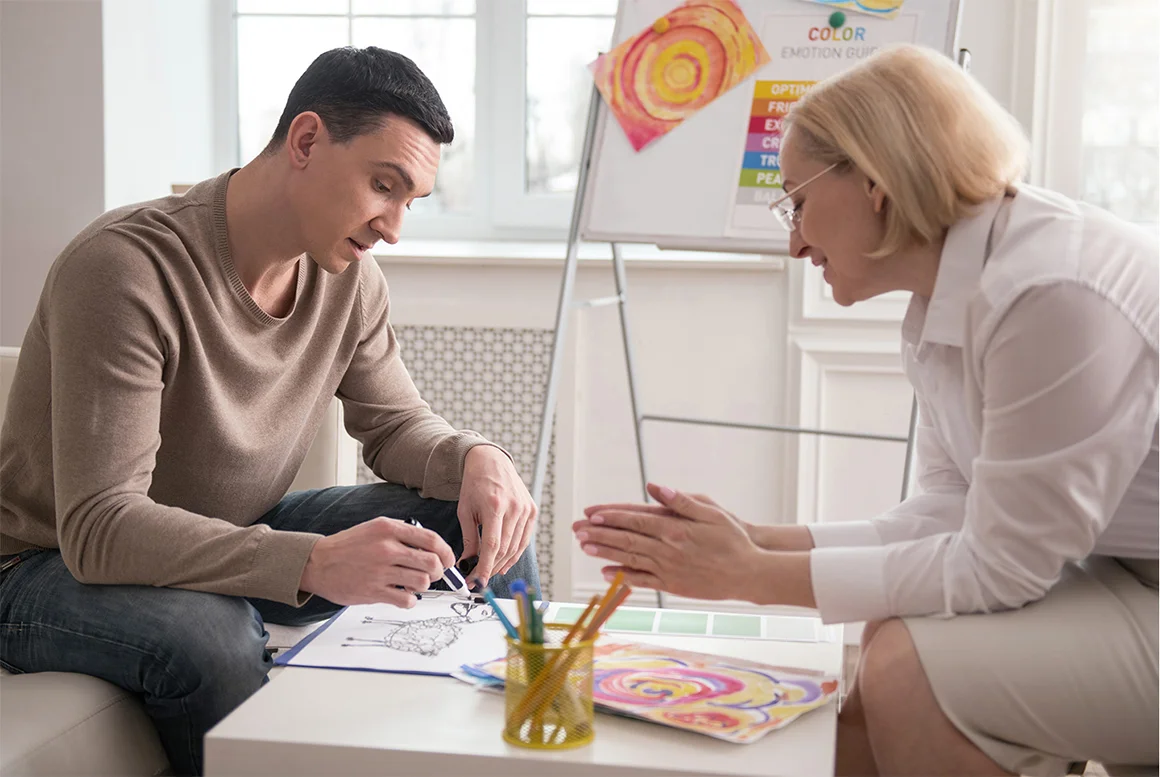
The Process of Art Therapy
Art therapy is a therapeutic process that begins with establishing a trusting relationship between the art therapist and the client. The therapist provides a safe space for the client to freely explore their feelings, thoughts, and experiences through creative self-expression.
Clients can use various forms of art and materials, including drawing, painting, sculpture, collage, writing, and many other forms of creativity, depending on their preferences and therapy goals.
During therapy, the art therapist helps the client analyze and interpret the meaning and emotions expressed in their artworks. This may involve discussing themes, metaphors, and symbols used in the art and how they relate to the client’s life experiences and feelings.
The art therapist may also use creativity as a tool for discussing and working through issues the client faces, helping to develop new skills and coping strategies.
How is an art therapy session prepared?
Preparing an art therapy session involves several key steps that help the art therapist create a productive and safe environment for the therapeutic process:
- Setting Goals: At the beginning, the psychologist and client define the therapy goals. This could be general emotional well-being improvement, addressing specific emotional issues, or learning new ways to express and understand feelings.
- Choosing Appropriate Materials: The art therapist selects various materials that the client can use for self-expression. These could include pencils, paints, clay, magazines for collages, as well as materials for more unconventional forms of art.
- Preparing the Space: The art therapist creates a safe and comfortable space for work. This includes ensuring quiet and privacy, as well as conveniently arranging materials and furniture.
- Session Planning: Based on the therapy goals, client preferences, and assessment of their current emotional state, the art therapist plans the session structure. This may include free creativity, thematic drawing, discussing and analyzing the client’s work, or a combination of these approaches.
- Preparing for Discussion: The art therapist also prepares for discussing the client’s work by studying various techniques for interpreting creativity and preparing open-ended questions that will help the client explore their feelings and thoughts more deeply.
All these preparation steps help the art therapist ensure an effective and empathetic therapeutic space for each art therapy session.
Example of an Art Therapy Session
An art therapy session can vary depending on the client, their needs, and therapy goals, as well as the art therapist’s approach. Below is an example of a typical procedure:
- Session Start: The art therapist greets the client and asks how their week went, what major events and feelings they experienced. This helps set the context for the session and determine what to focus on.
- Defining the Session Goal: Based on the discussion, the art therapist and client formulate a specific goal for the session. This might relate to a particular feeling, event, or problem the client wants to explore through art.
- Creative Time: The client gets time and materials to create their artwork. The art therapist ensures a comfortable and supportive atmosphere and remains available for questions or assistance if needed.
- Discussing the Work: After the client has completed their work, the art therapist helps them discuss and interpret their creativity. This may include discussing the choice of colors, shapes, metaphors, and symbols, and their relation to the client’s feelings and experiences.
- Session Conclusion: At the end of the session, the art therapist and client discuss what was useful or meaningful in the session and set goals or homework for the next meeting.
It is important to note that this process can be adapted and changed depending on the unique needs of each client.
Analysis and Interpretation of Creative Works in Art Therapy
Analysis and interpretation of creative works are key components of art therapy. This is a process where the art therapist and client jointly explore the meanings, significances, and emotions expressed in the client’s art.
It is important to note that the art therapist does not “read” the client’s works as someone might analyze and interpret artworks in an academic context. Instead, they use creativity as a means to facilitate conversation, helping the client express and explore their feelings and thoughts.
In this process, the following approaches are used:
- Exploring Material and Technique Choices: The art therapist may ask questions about the choice of materials, techniques, and styles used in the work and discuss how they reflect or relate to the client’s emotions and experiences.
- Working with Metaphors and Symbols: The art therapist helps the client explore the metaphors and symbols used in their art and relate them to their life experiences and feelings.
- Focusing on the Process: Sometimes, the process of creating the artwork can be just as important as the finished product. The art therapist may discuss the client’s experience of working on their creation, including any difficulties, pleasures, or emotions that arose during the process.
- Maintaining an Open Dialogue: The art therapist strives to maintain an open and non-directive approach, asking open-ended questions and offering the client the opportunity to express their own interpretations and emotions.
By applying these principles, approaches, and techniques, art therapy provides a powerful tool for healing, self-discovery, and personal growth.
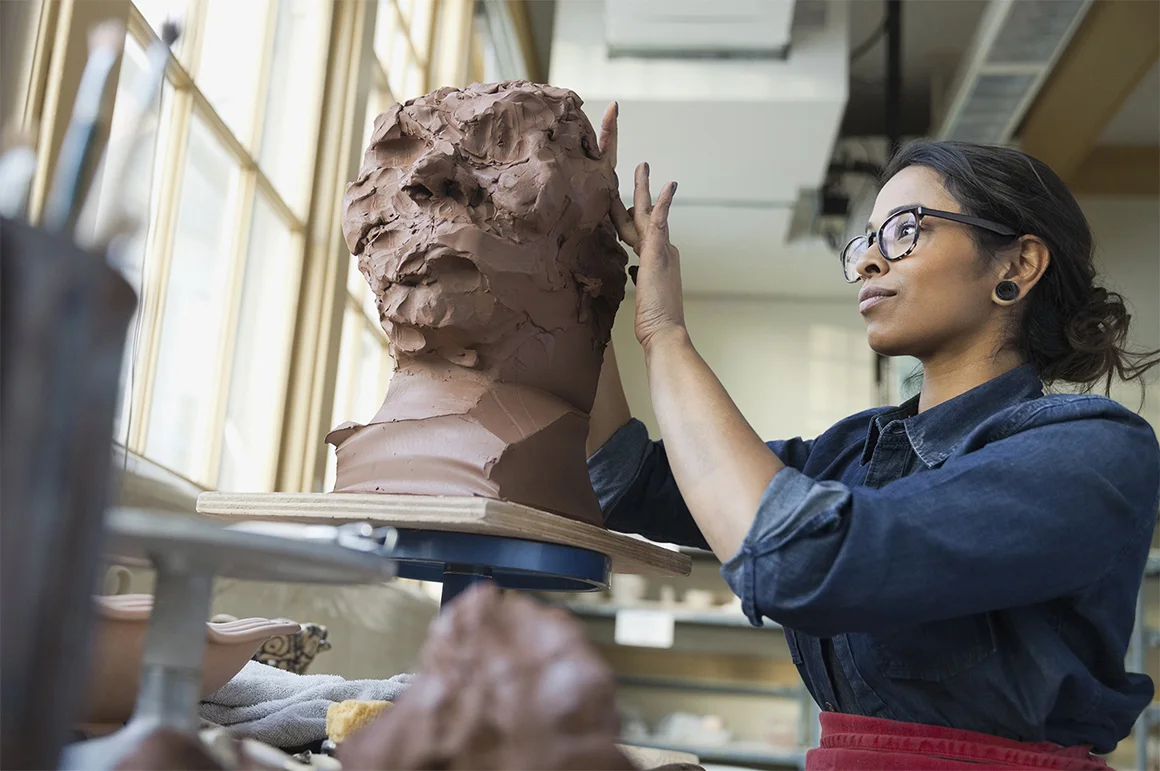
Art Therapy: Effectiveness and Applications
Art therapy has been recognized as an effective form of psychotherapy used to improve mental health and well-being. Numerous studies have shown its efficacy in helping people cope with a wide range of issues, including stress, anxiety, depression, trauma, loss, and illness.
Art therapy has also proven effective in working with children and adults with special needs, including those with autism, intellectual disabilities, and age-related conditions. Creating art and discussing it in therapy sessions promote awareness and expression of feelings, development of stress-coping skills, and enhancement of self-esteem.
The application of art therapy extends beyond clinical settings. It can also be effective in educational institutions, social services, prisons, communities, and workplaces for promoting overall well-being and developing social-emotional skills.
In educational settings, for instance, art therapy helps students manage stress, improve attention span, and enhance interpersonal relationships. In workplaces, it can be used to reduce stress levels, increase productivity, and improve team dynamics.
Research Validating the Effectiveness of Art Therapy
- Autism: A study published in the Journal of Autism and Developmental Disorders demonstrated significant improvement in social interaction and reduction of autism symptoms among children participating in art therapy programs.
- Post-Traumatic Stress Disorder (PTSD): Research conducted at the Uniformed Services University of the Health Sciences showed that veterans with PTSD experienced symptom reduction and improved well-being after participating in art therapy.
- Oncology: A study in the Journal of Pain and Symptom Management indicated significant reductions in pain, fatigue, and other cancer-related symptoms among patients participating in art therapy.
- Depression: Research published in The Arts in Psychotherapy found that art therapy helps reduce symptoms of depression and improve quality of life.
- Elderly Population: An article in The Gerontologist confirmed that art therapy improves memory, increases energy levels, and enhances overall well-being in elderly individuals.
These studies represent only a fraction of extensive data confirming the efficacy of art therapy across various contexts and for diverse groups of people.
Applications of Art Therapy in Various Fields
Art therapy is widely applied across many domains as an effective means of enhancing mental and emotional well-being.
- Psychology: In psychology, art therapy helps individuals express and become aware of feelings and thoughts that are difficult to verbalize, particularly beneficial for children facing communication challenges.
- Psychiatry: In psychiatry, it complements standard medical therapy for serious mental disorders such as schizophrenia, bipolar disorder, and clinical depression, aiding patients in managing symptoms and improving overall quality of life.
- Social Services: In social services, it supports vulnerable populations, including individuals with special needs, at-risk youth, elderly individuals, and those struggling with addictions, helping them process complex emotions, cope with traumatic events, and improve interpersonal skills and self-esteem.
- Education: In educational institutions, art therapy supports students with diverse learning needs, helping them cope with stress, enhance attention span, improve social-emotional skills, and interpersonal relationships.
- Gerontology: Working with the elderly, art therapy helps to cope with fears and anxieties associated with the psychology of old age, loss of loved ones and health problems.
- Oncology: In oncology, it is used to reduce stress and enhance the quality of life for cancer patients, facilitating expression and processing of emotions related to illness and treatment, and improving their ability to cope with the disease.
- Rehabilitation: Art therapy plays a significant role in physical and psychological rehabilitation, aiding in motor skill improvement, motivation enhancement, and mood elevation for individuals recovering from injury or illness.
- Environmental Conservation: In the context of ecopsychology, art therapy fosters a connection between individuals and the environment, promoting sustainable lifestyles and environmental awareness.
- Correctional Facilities: Art therapy is also used in prisons to teach inmates stress management, develop positive ways of expressing feelings, and improve social skills for successful reintegration into society post-release.
- Business and Corporate Settings: In the corporate world, art therapy is used to enhance teamwork, reduce stress levels, stimulate creative thinking, and improve interpersonal relationships in the workplace.
These examples demonstrate the unique versatility of art therapy as a form of treatment and support applicable across diverse contexts and fields.
Art Therapy Across Different Age Groups and Issues
Art therapy demonstrates unique flexibility and can be adapted to work with people of different age groups and a wide range of issues.
- Children: For children, art therapy provides a safe and creative way to express feelings and experiences, especially beneficial for those facing verbal communication challenges, complex emotions, or trauma. It also helps improve social skills, self-respect, and self-regulation.
- Adolescents: For adolescents dealing with peer pressure, school stress, or personal issues, art therapy can be a constructive way to process these challenges. It can also be an effective tool for helping at-risk teens suffering from depression and anxiety.
- Adults: Adults can use art therapy to address anxiety, stress, depression, or psychological trauma. It can also be beneficial practice for adults dealing with mental disorders or health issues. In business and corporate settings, art therapy is used to improve teamwork and reduce stress in the workplace.
- Elderly Individuals: Art therapy helps elderly individuals improve memory, motor skills, and mood. It is particularly beneficial for people with dementia or Alzheimer’s disease.
- Specific Issues: Art therapy is also used to treat specific problems such as PTSD, eating disorders, autism, addictions, and stress-related illnesses.
Thus, art therapy represents a universal approach that can be individually tailored to address the needs of people of different ages and various life circumstances.
Criticism of Art Therapy
Like any approach to psychotherapy and treatment, art therapy faces certain criticisms and questions. Despite numerous studies demonstrating its effectiveness, there are some points that spark debate:
- Lack of High-Quality Research: While many studies have shown the effectiveness of art therapy, critics argue that some studies have small sample sizes or use less rigorous methodologies, which may affect the credibility of conclusions.
- Difficulty in Measuring Outcomes: Art is a subjective experience, and what one person expresses or experiences through creativity may be interpreted differently by others. This creates challenges in measuring and evaluating the outcomes of art therapy.
- Lack of Standardization: There are numerous different approaches and techniques in art therapy, and it is not always clear which ones are most effective for different clients and situations. This inconsistency can lead to variability in the practice of art therapy.
However, these challenges do not negate the value and potential of art therapy. They underscore the importance of continuing research and developing better practice standards in this field.
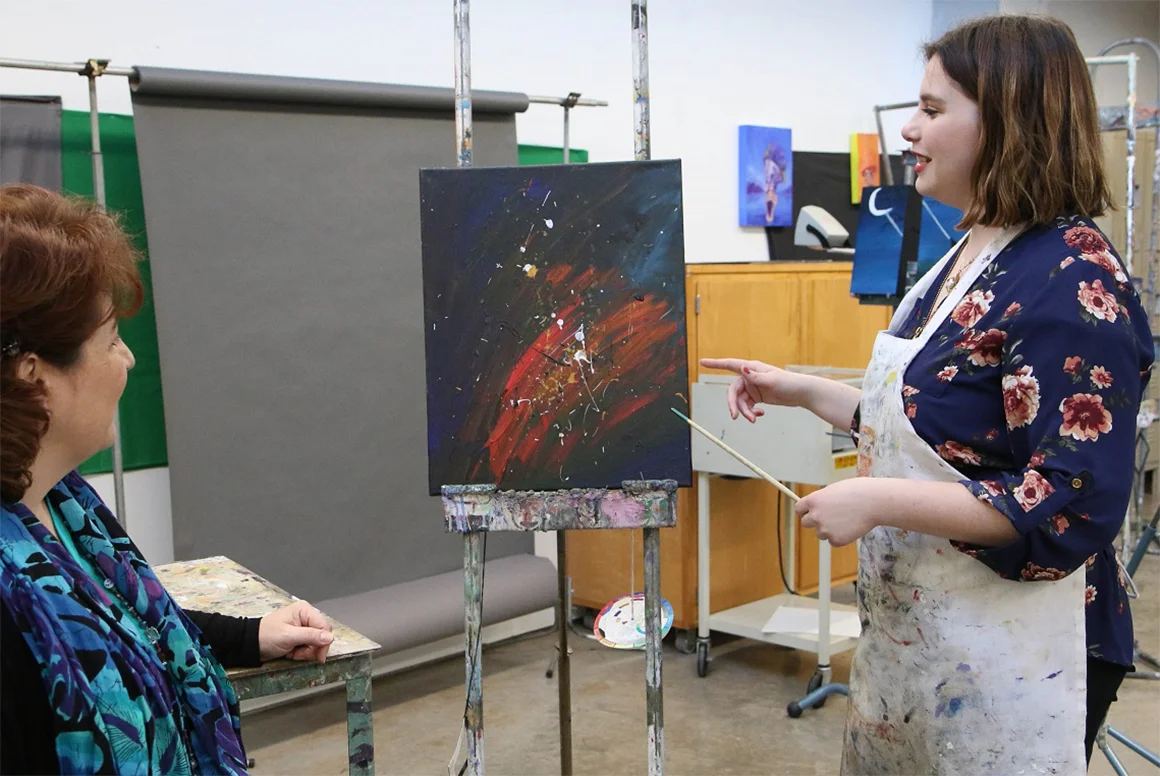
Prospects for the Development of Art Therapy
The prospects for the development of art therapy are extensive, as this approach continues to garner increasing attention both in medical research and in a wide range of practical applications.
- Research Endeavors: There is ample opportunity for further research in art therapy. More studies are needed to examine the effectiveness of different approaches and techniques of art therapy in addressing various populations and issues.
- Integration with Other Therapies: Art therapy can be complemented and integrated with other forms of therapy, such as cognitive-behavioral therapy, music therapy, psychodrama, etc., creating a holistic approach to treatment.
- Online Art Therapy: With the growth of technology and digital communication, online art therapy is becoming increasingly popular. This opens up new possibilities for access to art therapy for those who may otherwise not have access to it.
- Professional Development and Training: As interest in art therapy grows, so does the need for training and professional development for therapists. This may include more courses, certification programs, and educational initiatives.
- Cultural Adaptation: Art therapy is spreading globally, necessitating adaptation of approaches and methods to fit the cultural characteristics of different peoples and communities.
Overall, the prospects for art therapy are promising, with many opportunities for further research, development, and application of this valuable therapeutic approach.

Useful Literature on Art Therapy
- “The Handbook of Art Therapy” – Cathy Malchiodi. This is a comprehensive reference for practicing art therapists, students, and anyone interested in art therapy.
- “Art Therapy Sourcebook” – Cathy Malchiodi. This accessible resource introduces the concepts and practice of art therapy, with self-help exercises.
- “Art Therapy for Groups: A Handbook of Themes and Exercises” – Marian Liebmann. This detailed guide to group art therapy includes various themes and exercises.
- “Art Heals: How Creativity Cures the Soul” – Shaun McNiff. Here, the author explains how art helps in the treatment of various types of psychological trauma and stress.
- “Art Therapy Techniques and Applications” – Susan Buchalter. This book offers various art therapy techniques that can be used with children, adolescents, and adults.
- “Art Therapy and Clinical Neuroscience” – Richard Carr. This book presents research and practices of art therapy within the context of neuroscience, bridging these two areas of knowledge.
- “Using Art Therapy with Diverse Populations” – Paula Howie. This book provides examples of applying art therapy with various population groups.
- “Art Therapy and Health Care” – Cathy Malchiodi. This book examines the role of art therapy in various medical contexts, from hospitals to mental health clinics.
These books cover different types of art therapy and are valuable for understanding its theory and practice.
